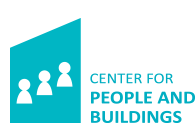Places and Activities Model

Insight into Required Workplaces and the Consequences of Choices
Many organizations would like to adapt their business accommodations to their work processes. The big question then becomes, “How to achieve a work environment that fits an organization and its work processes?”
Many decisions must be made. Questions arising while making these decisions include:
- Which starting points do we employ?
- Do we want employees to share workplaces?
- Which workplace concept best fits our organization?
- How many and what type of workplaces will we implement?
- Which consequences are implied by these choices?
- How can we use organizational measures to influence accommodations requirements?
In the past few years, CfPB has explored these and similar questions through various projects, with various partners. Thus, we developed the model Places and ACTivities (PACT).
Mathematical Model
PACT is a mathematical model which uses data on the number of people to be accommodated and the answers to the above questions to calculate various solutions. The initial values are manipulated (through input of different data) to produce a variety of results. These results then inspire discussions on strategic initial values and their consequences. Thus, PACT functions as a support to decision-making: calculation and reasoning go hand in hand.
Insight into Activities in the Work Process
In order to use PACT, some basic data is necessary, such as insight into time spent on specific activities, (future) work processes and relationships. Time spent on an activity is called an activity pattern. Working with the organization, these are grouped by function, team, department, for the whole organization, or based on a specific work process (e.g. presence or lack of client contacts). Additionally, data is required describing the number of employees and, depending on the operating process, the number of clients, students, patients, etc.
Insight into Accommodations Policies and Starting Points
To use the model, (some) prior knowledge of accommodations policies is necessary. This involves the suitability of places for specific activities, to what extent the accommodations are utilized and assigned (occupancy rates and workplace sharing arrangements), the chosen types of workplace and their dimensions and, last but not least, the goals for the (new) accommodations. An understanding of principles concerning the work environment is needed in order to discuss how to match the accommodations to the work processes within the organization.
Who and when?
PACT is intended for management and project teams and may be deployed at three stages:
- While developing new accommodations policies
- When initiating new accommodations projects; what consequences do the various options have?
- During the defining phase, to generate input for the design brief
What good is it?
Using PACT gains you the following:
- A comprehensive picture of principles concerning accommodations
- Insight into anticipated issues within the organization and their consequences for the accommodations (utilization)
- Insight into various options for influence concerning accommodations
- Insight into the number and types of workplaces and the required surface area
- Input for the architectural design brief concerning the number and types of workplaces and their placement relative to each other
- Input for the business case
How does it work?
PACT is usually applied using workshops. Prior to the workshop(s), information gathered during one or more conversations is to set the model's initial values. During the workshop itself, policy choices and future expectations are discussed through the calculation of various scenarios.
Contactperson

